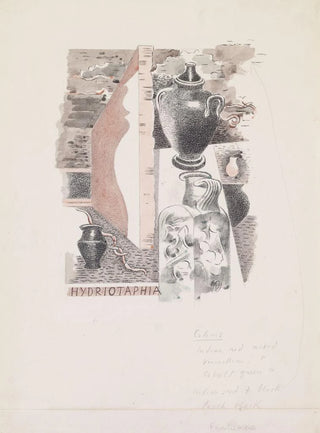Art print | L'eau s'est avérée être la tombe la plus intelligente - Paul Nash


View from behind

Frame (optional)
Paul Nash's artwork "L'eau s'est avérée être la tombe la plus intelligente" embodies a profound reflection on nature and memory, while evoking themes of war and destruction. In this piece, Nash manages to capture the essence of a devastated landscape, where water, a symbol of life and renewal, transforms into a tragic element. The composition, both poetic and unsettling, invites viewers to contemplate the contrast between the beauty of nature and the scars left by humanity. This work does not merely depict a landscape; it engages in a dialogue with the past, questioning our relationship with the environment.
**Style and uniqueness of the work**
Paul Nash's style is distinguished by a surrealist and symbolic approach, where each element of the painting carries a deep meaning. In "L'eau s'est avérée être la tombe la plus intelligente," organic shapes blend with more austere structures, creating a palpable tension. The use of dark colors and earthy tones enhances the melancholy emanating from the scene. Nash skillfully plays with light and shadow, evoking an atmosphere that is both dreamlike and nightmarish. This painting demonstrates exceptional mastery of composition, where every detail is carefully considered to reinforce the overall message. The juxtaposition of water and debris reminds viewers of life's fragility and how nature can both preserve and destroy.
**The artist and his influence**
Paul Nash, a prominent figure of the British surrealist movement, left a significant mark on his era with his powerful and evocative works. Born in 1889, he was deeply influenced by the traumatic events of World War I, which left an indelible imprint on his work. Nash often used landscape as a means of expression, transforming familiar scenes into reflections on war, memory, and identity. His unique approach paved the way for many contemporary artists, who see in him a source of inspiration for addressing complex subjects through the lens of nature. Nash's impact on art

Matte finish

View from behind

Frame (optional)
Paul Nash's artwork "L'eau s'est avérée être la tombe la plus intelligente" embodies a profound reflection on nature and memory, while evoking themes of war and destruction. In this piece, Nash manages to capture the essence of a devastated landscape, where water, a symbol of life and renewal, transforms into a tragic element. The composition, both poetic and unsettling, invites viewers to contemplate the contrast between the beauty of nature and the scars left by humanity. This work does not merely depict a landscape; it engages in a dialogue with the past, questioning our relationship with the environment.
**Style and uniqueness of the work**
Paul Nash's style is distinguished by a surrealist and symbolic approach, where each element of the painting carries a deep meaning. In "L'eau s'est avérée être la tombe la plus intelligente," organic shapes blend with more austere structures, creating a palpable tension. The use of dark colors and earthy tones enhances the melancholy emanating from the scene. Nash skillfully plays with light and shadow, evoking an atmosphere that is both dreamlike and nightmarish. This painting demonstrates exceptional mastery of composition, where every detail is carefully considered to reinforce the overall message. The juxtaposition of water and debris reminds viewers of life's fragility and how nature can both preserve and destroy.
**The artist and his influence**
Paul Nash, a prominent figure of the British surrealist movement, left a significant mark on his era with his powerful and evocative works. Born in 1889, he was deeply influenced by the traumatic events of World War I, which left an indelible imprint on his work. Nash often used landscape as a means of expression, transforming familiar scenes into reflections on war, memory, and identity. His unique approach paved the way for many contemporary artists, who see in him a source of inspiration for addressing complex subjects through the lens of nature. Nash's impact on art






